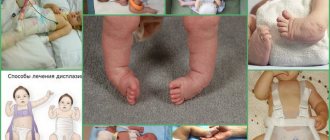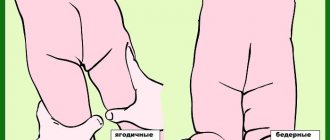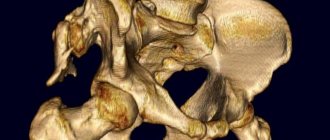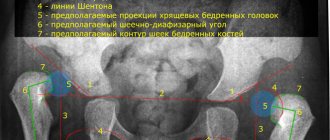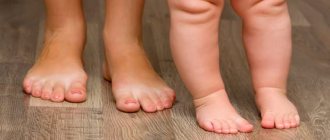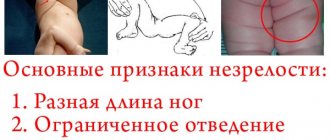Congenital hip dislocation and dysplasia
Which doctors should I contact?
The clinical picture of the disease can be blurred, so it is imperative to visit a pediatric orthopedist in the first year of a child’s life.
Treatment of congenital hip dislocation
Treatment is selected individually for each small patient and depends on age, weight, clinical and radiological picture. Treatment is usually complex and long-term - from several months to a year.
The main task of conservative therapy is the correct comparison and fixation of the femoral head in the acetabulum in order to ensure the correct formation of the joint in the future. Standard treatment methods include:
- Wide swaddling
- two diapers are placed between the baby’s legs, giving the position of flexion and abduction in the hip joints, and the third one fixes the legs, which allows maintaining the position of abduction and flexion at an angle of 60-80°. - Frayka pillow (splint)
is a special orthopedic device that is placed and secured between the child’s legs, which allows you to fix the hips in an abducted position at the required angle (90⁰ or more). Wearing a Freik splint is indicated for children under 1 year of age with pre-dislocation or subluxation of the hip to ensure the correct formation of the hip joint in case of confirmed dysplasia. In case of complete dislocation of the hip joint, the product is contraindicated. - Pavlik's soft stirrups
are the most gentle orthopedic product for the hip joint and the most comfortable for children and parents; they are considered the gold standard of pediatric orthopedics. It is used to reduce and fix congenital dislocation of the hip joint in a functionally advantageous position until the joint has fully matured. - Functional rigid plaster casts
are applied for high hip dislocation in young children, untreated subluxation in children 1-1.5 years old with the presence of adductor contracture of the hip muscles. - Abduction splints
can be used to completely stabilize the joint. For children over the age of 1 year, it is recommended to wear John and Korn abductor orthoses - special devices that do not allow the child to bring his legs together, but at the same time leave the possibility of independent walking. Such orthoses are worn in case of pre-dislocation or subluxation of the hip, as well as in the postoperative period for correct rehabilitation.
In parallel, physiotherapeutic treatment and, if necessary, massage are carried out.
It is worth noting that when treating hip dysplasia, a small patient does not begin to walk for a long time. At this point, it is important that parents do not force this process. The optimal age for starting conservative treatment is the first days of a child’s life. If the pathology was discovered after the child reached 1-2 years of age or with an obvious dislocation of the hip, then the effectiveness of the bandage is significantly reduced, so doctors recommend surgical intervention.
Surgical intervention is prescribed for children older than 12-24 months in case of failure or futility (in the opinion of the attending physician) of conservative therapy, as well as in the presence of complete hip dislocation. In the postoperative period, the child is advised to wear abduction orthoses, sometimes for a long period - up to 12 months.
You need to understand that congenital hip dislocation is not a simple traumatic dislocation, but a consequence of the inferiority of the hip joint itself.
In some cases, closed reduction of the dislocation helps solve the problem. This method is most effective if the child is under 24 months of age, but it does not replace subsequent wearing of abduction orthoses or even surgical intervention, since without eliminating hip dysplasia, the problem will be detected again and again. In the future, the effectiveness of closed reduction decreases, and after 5 years its use is contraindicated.
Complications
It must be remembered that untreated and untreated dysplasia, dislocations and subluxations of the hip can lead to lameness and disability. In advanced cases, we are often talking only about eliminating the pain syndrome and restoring the ability to lean on the leg.
If dysplasia is not eliminated in a timely manner, the child may develop osteochondrosis, scoliosis, poor posture, coxarthrosis, flat feet, shortening of one leg, neoarthrosis, aseptic necrosis of the femoral head and disability.
The occurrence of recurrent hip dislocations and subluxations is most often associated with early cessation of skeletal traction and premature loading on the injured limb. This entails adverse consequences that sharply disrupt the static-dynamic function of the limb, and often requires long-term, difficult and persistent rehabilitation treatment. Hip replacement can successfully solve problems, but such an operation is only possible in adult patients with an already formed skeleton.
Prevention of congenital hip dislocation
Orthopedic examination of newborns is mandatory. You cannot swaddle the baby tightly, forcefully straighten the legs, or put the baby on his feet prematurely.
The femoral head consists of cartilage tissue. The ossification core is located inside the femoral head and, gradually increasing, it seems to reinforce it from the inside and gives the structure stability under axial load. In the absence of an ossification nucleus, any axial load on the hip leads to its deformation, as a result of which subluxation and then hip dislocation can develop. Accordingly, if the ossification nucleus does not develop or develops with a delay, any axial loads are strictly prohibited: standing, much less walking, is prohibited.
The formation of ossification nuclei is influenced primarily by activity. It is recommended to do gymnastics with your baby every day immediately after birth. This should be a normal, static load, when the child lies and the mother spreads his arms and legs. We categorically do not recommend “dynamic gymnastics” - a set of exercises in which the child is twisted, twirled, rocked, rotated by the arms and legs, etc. From 2.5 months, the child can and even needs to go to the pool.
With timely treatment, it is possible to completely eliminate congenital hip dislocation or even prevent its development if dysplasia was discovered in infancy. After the first 3-4 months of a child’s life, the prognosis for the success of conservative treatment worsens, and the necessary course of therapy takes much longer.
Sources:
- A.G. Baindurashvili, S.Yu. Voloshin, A.I. Krasnov Congenital dislocation of the hip in infants. Clinic, diagnosis, conservative treatment and rehabilitation. St. Petersburg, SpetsLit, 2016, 103 P.
- Treatment of high congenital hip dislocation in young children. Clinical recommendations. All-Russian public organization Association of Traumatologists and Orthopedists of Russia, Moscow, 2014.
- Kamosko M.M., Poznovich M.S. Conservative treatment of hip dysplasia. Orthopedics, traumatology and reconstructive surgery of children. Volume II. Issue 4. 2014. pp. 51-60.
IMPORTANT!
The information in this section cannot be used for self-diagnosis and self-treatment. In case of pain or other exacerbation of the disease, diagnostic tests should be prescribed only by the attending physician. To make a diagnosis and properly prescribe treatment, you should contact your doctor.
The benefits of paraffin therapy for the treatment of pediatric hip dysplasia
The effect of the substance used for paraffin therapy for hip dysplasia in children is that when heated, energy is absorbed and distributed equally over the entire plane of the skin. As a result, there is an increase in body temperature in the areas of application of the product up to 2°C, intense steaming of the pores, as well as activation of the activity of the exocrine glands. The procedure ensures the release of a significant amount of sweat, including harmful elements accumulated as a result of the development of the inflammatory process.
Immediately after a paraffin therapy session, the skin, deprived of an abundance of moisture, vigorously absorbs water. This helps to improve the quality and elasticity of the outer level of the epidermis. When cooled, the product contracts, stimulating the skin, enhancing the functioning of the circulatory system.
Please note: toxins released through sweat are absorbed into the paraffin. In this regard, any subsequent manipulation involves the use of a pure product without the addition of used raw materials.
Preparatory actions
To treat hip dysplasia, a cuvette type of application is used. The manipulation is performed in a hospital setting or at home. The composition of the medicinal mixture includes:
- cosmetic paraffin - 0.5 kg,
- ozokerite - 0.25 kg,
- Vaseline oil - 1 pc.
In addition to the solution, the procedure requires a thick medical oilcloth to form a frozen mass in it.
Oilcloth for forming paraffin mass
Homemade medicinal solution is prepared using two enamel containers of different sizes. Fill a large saucepan with less than half the total volume of water. Place the crushed main raw materials in another container, add petroleum jelly and place in a container with water. Place the resulting structure on the stove for 60 minutes to melt over low heat. The product must be stirred systematically with a wooden spatula.
While the medicinal solution for DTS therapy is being prepared, you need to make a filler for the mixture. To do this, sides are created from the ends of the oilcloth, which are secured along the edges with clothespins or other clips. To be on the safe side, place the resulting form on a metal baking sheet or wide tray.
The melted mass is poured into the oilcloth blank to a level of 1 cm. After 10-15 minutes it will thicken. To avoid burns, you should check the readiness of the product by carefully piercing it in the center with a toothpick. The frozen medicine is removed and used for its intended purpose.
It is worth taking care of the place where the procedure will be performed in advance. A thick blanket or blanket is spread on a flat surface. A thin cloth is laid out on top and the resulting product is placed on it. You can put a cotton diaper on top.
Types of paraffin-based applications
The application method involves applying certain medications to the affected area. The use of this therapeutic method in the treatment of hip dysplasia consists of thermal effects on damaged areas of the body.
There are several types of manipulations using paraffin:
- Cuvette. The mass is melted, poured into a spacious container until it hardens and applied to the affected area of the skin.
- Multilayer gauze. A piece of gauze soaked in a liquid medicinal mixture, folded in several layers, is distributed over the required surface of the body and left for a certain time. It is recommended to do the manipulation three times.
- Layering. Multi-level application of the product using a paint brush.
Recommended period of paraffin therapy
It is advisable to make therapeutic paraffin applications on the hip joints of a baby from the first months of life. Timely detection of pathology using an X-ray machine will provide an opportunity to eliminate the disease with an integrated approach to solving the problem.
In accordance with the level of complexity of the deviations, a long treatment course of more than 6 months of paraffin therapy will be required. The doctor prescribes 10 to 20 procedures, performed every other day. Then there is a break for a month, after which therapy is resumed.
It is important to maintain continuity in treatment, monitor the process and strictly follow medical recommendations.

